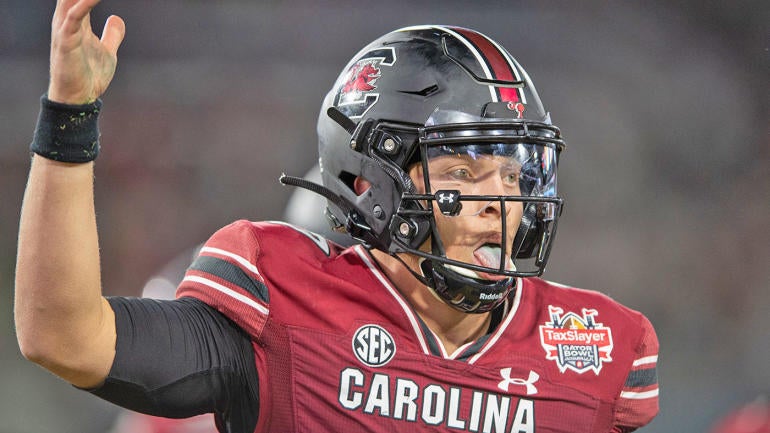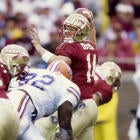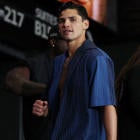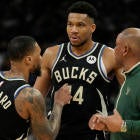
If you're creating the perfect NFL Draft prospect, he'd be huge, with tremendous collegiate production and awe-inspiring athletic gifts. Of course, most don't check all those boxes. Sometimes you have to trust a prospect's film even if he's not an athletic freak.
This is the first in a two-part, annual series that examines a pair of unique subsets of every draft class. Below are NFL hopefuls who don't have requisite physical traits or maybe didn't crush their combine/pro day workouts, yet I still really like and believe in as prospects. They can be good at the NFL level, I'm telling you!
These are my "Trust The Tape" prospects for the 2024 class.
Irving's combine was such a downer for me. I had already fallen in love with his game at Oregon on film, and I wasn't overly concerned about his noticeable lack of size because today's NFL is increasingly featuring smaller, lighter players.
But, man -- a 4.55 at 5-foot-9 and 192 pounds is one thing. The 29.5-inch vertical is another. Same with the 9-foot-7 inch broad jump. Woof. It just didn't compute in my brain that the Oregon runner I had watched make like every single defender in the Pac-12 miss on a routine basis would test so poorly.
However, the production does not lie, and it speaks to Irving's ability to overcome his lack of sheer explosion or long speed. In 2022, after transferring to Oregon from Minnesota, Irving forced 67 missed tackles on 157 carries. HELLO. As the feature back with the Ducks this past season, the missed tackles forced figure was 69 from Irving on 186 attempts. Dude is elusive! You know who's another small, ultra-productive collegiate runner with a completely lackluster combine workout who's become a quality professional -- Devin Singletary. Irving can still rock in the NFL, lack of size and bad combine workout be damned.
Before the combine, I had a first-round grade on Rattler. That's how enamored with his film -- and the traits he demonstrated on film -- I was. Then he unfortunately tanked his combine workout. Now, I know what you may be thinking ... combine workouts don't really matter for quarterbacks. To me, they do. There's an athletic minimum that almost needs to be met in today's NFL at the position, or it's almost a lock that a quarterback won't succeed.
Rattler ran 4.95 in the 40 (!) with the slowest three-cone and short shuttle of the four quarterbacks who did those agility drills. Oh, and he was barely 6-foot and 212 pounds. Objectively, he's a very low-level athlete by today's standards. On film, Rattler still exudes the confidence of a former No. 1 overall quarterback recruit in the nation. Remember, he rocked as a redshirt freshman at Oklahoma in 2020 and jumped to the top spot in many way-too-early mock drafts that May.
The arm talent is undeniable, and despite his low-level athleticism, he made plenty of SEC defenders miss behind what was an abomination of an offensive line. If there's an early-to-mid Day 3 quarterback in this class who has the throwing goods to become a starter in this league, it's Rattler.
I adore McGlothern as a prospect but get the sneaking suspicion he's going to be available well in the third day of the draft. The longer you evaluate entire draft classes, the easier you can pinpoint the prospects you're totally against the grain on, and McGlothern is one of those prospects this year.
After transferring from LSU, the long, lanky defensive back rocked for the Razorbacks with seven picks, 16 pass breakups, and three forced fumbles in two seasons. Given that he played in the SEC, you'd think he'd have to be an elite-level athlete to compile those figures. He's not. McGlothern has one of the most unique body type/athletic profiles in the entire class. He's nearly 6-foot-2 but under 190 pounds with arms under 31 inches and 4.47 speed. The vertical was only 32 inches, and McGlothern jumped just 9-foot-7 in the broad.
On film, he's considerably more fluid and bendy than sudden and fast, and the former LSU defensive back plays with stellar instincts in zone, which sparked many of the instances in which he got his hand on the ball in college. Now, if he's drafted by a team and said team's defensive coordinator asks him to chase in press-man coverage, McGlothern will not materialize into an asset at the next level. If he's selected by a club that deploys him in zone, his coverage savvy will illuminate, and this Arkansas product can be one of the biggest defensive back bargains in the class. Watch the LSU and Florida games for evidence.
Look at the entirety of Thrash's combine, and you'll realize why he was a candidate for this piece. Not quite 6-foot and 188 pounds with 4.46 speed, a 34-inch vertical, 10-foot broad jump, plus a three-cone well above the magical seven-second threshold (7.16).
While all that represents a somewhat underwhelming physical profile on the surface, Thrash is a baller on the field with a complete skill set. I love that, despite his diminutive size, he mostly aligned -- and won -- as a perimeter wideout in the ACC. No easy task. His lightning-quick feet and hand work allow him to beat press with reasonable regularity, he runs with sharp-breaking cuts in his routes -- vital today, of course -- and is sneaky-good after the catch.
In his collegiate career at two schools across five seasons, Thrash managed a missed tackle forced rate of 24.4%, higher than the likes of Xavier Worthy, Brian Thomas Jr., Jalen McMillan, Ja'Lynn Polk, and Xavier Legette. His vision, efficient cutting skill, and deceptively good balance to absorb contact in space combine together to give him serious YAC powers. Somewhere on Day 2, or early Day 3, Thrash is going to be a steal.
Abrams-Draine has been on the draft radar for a while, and after a three-interception, seven-pass breakup debut season at Missouri, the small-but-chippy cornerback defended 27 more passes with four picks and 99 total tackles in the following two seasons with the Tigers.
While I'm always trying to provide more than just box-score scouting, I do have a rule that the cornerbacks with plenty of classic production are probably doing something right on the field and are either freaky athletes or super-instinctive defenders. Abrams-Draine is more of the latter. At a hair over 5-foot-11 and 179 pounds, he's built to play nickel but repeatedly thrived on the perimeter in the SEC nonetheless. At the combine, Abrams-Draine ran a close-to-the-middle-of-the-pack 4.44 with an average-ish 33.5-inch vertical. In my estimation, he has just enough athletic chops to survive in the NFL, and his propensity to make plays in coverage will continue because of how quickly he reacts to route concepts. The cherry on top with Abrams-Draine -- he's the most reliable tackling cornerback in the class. I usually don't write this with lesser athletes, but I will be surprised if he doesn't become a successful professional.
When it comes to ticking the production box, you grab the fattest Sharpie in your junk draw and use it for that section of Trice's draft profile. This man registered 150 quarterback pressures on fewer than 870 pass-rushing snaps the past two seasons at Washington. And this was not by accident, or two years of exquisite game-planning, or relentless stunts that provided Trice a runaway to the quarterback repeatedly.
He won with a dazzling array of pass-rush moves, arguably the best in the class. He's a master with his hands, and that matters in the NFL ... especially if you're not a high-caliber athlete. And Trice's combine proved he's average at best athletically for the position. Weirdly too, after being listed over 260 pounds, Trice was 245 in Indianapolis and ran 4.72 with one of the slowest 10-yard splits among the edge rushers.
Sometimes, a stellar collegiate player is simply not athletic enough to thrive in the NFL. But Trice was so good across multiple seasons and does not rely on his athleticism really at all -- his game is predicted on flexibility, leverage, and especially his hand work. He exemplifies the trust the tape adage, because his tape is that spectacular.

































